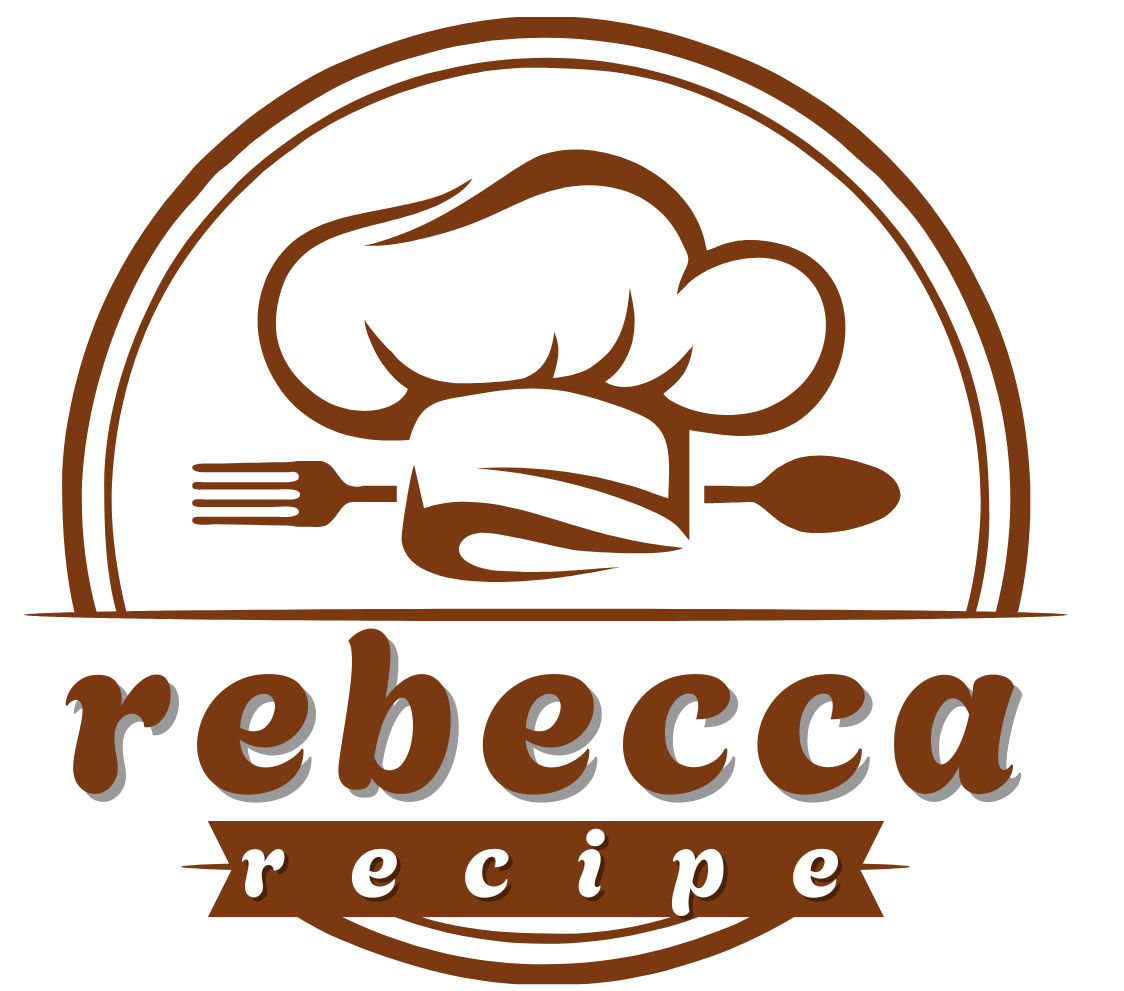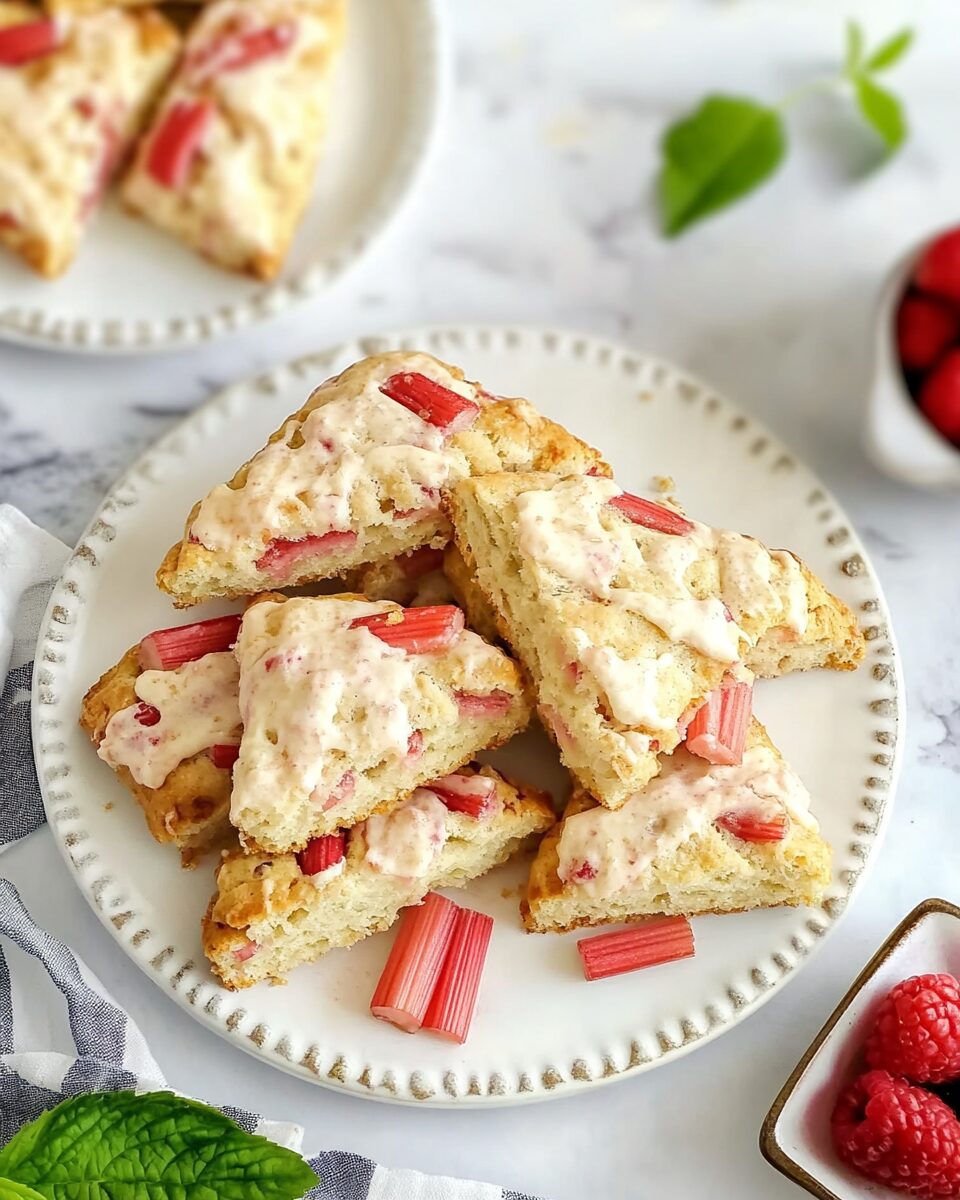Rhubarb scones are a delightful baked treat that combines the tartness of fresh rhubarb with a buttery, slightly sweet scone dough. These scones are perfect for breakfast, brunch, or as a dessert. The unique flavor of rhubarb adds a tangy twist to the traditional scone, making them a favorite during rhubarb season.
Full Recipe:
Ingredients
- All-purpose flour
- Granulated sugar
- Baking powder
- Baking soda
- Ground cinnamon
- Fresh rhubarb, diced
- Heavy whipping cream
- Powdered sugar (for glaze)
- Vanilla extract (for glaze)
Directions
- Preheat the oven to 400°F (200°C).
- In a large bowl, combine flour, sugar, baking powder, baking soda, and cinnamon.
- Add the diced rhubarb to the dry ingredients and mix well.
- Pour in the heavy whipping cream and stir until the dough comes together.
- Turn the dough out onto a floured surface and knead gently.
- Shape the dough into a circle about 1 inch thick and cut into 8 wedges.
- Place the wedges on a baking sheet lined with parchment paper.
- Bake for 15-20 minutes or until golden brown.
- While the scones are baking, prepare the glaze by mixing powdered sugar, vanilla extract, and a small amount of cream until smooth.
- Once the scones are baked and slightly cooled, drizzle the glaze over the top.
Nutritional Information (per serving, based on 8 servings)
- Calories: Approximately 250-300 kcal
- Protein: 4-5 grams
- Fat: 12-15 grams
- Carbohydrates: 30-35 grams
- Fiber: 1-2 grams
- Sugar: 10-15 grams
- Sodium: 200-250 mg
The History of Scones: A Traditional British Delight
Scones are an iconic part of British baking tradition. First originating in Scotland, scones have been enjoyed for centuries as a simple, quick bread that pairs perfectly with tea. Traditionally, scones were made with just flour, butter, milk, and a little bit of sugar, resulting in a lightly sweetened biscuit-like texture. Over time, variations of scones have developed, including the addition of fruits, nuts, and even chocolate.
Rhubarb scones are a more modern take on this classic treat, incorporating the seasonal tang of rhubarb into the dough. Rhubarb has long been a favorite in desserts and pastries, often paired with strawberries or other fruits to balance its tart flavor. When added to scones, rhubarb provides a refreshing twist, elevating the dish from a simple pastry to something more exciting and flavorful.
Why Choose Rhubarb for Your Scones?
Rhubarb is a vegetable that is often mistaken for fruit, thanks to its tangy, slightly sweet flavor. It has been used in culinary applications for centuries, especially in baking and jams. The vibrant pink and green stalks of rhubarb are both visually striking and packed with flavor. When baked into scones, rhubarb’s acidity creates a perfect contrast to the buttery richness of the scone dough, resulting in a light, fresh, and slightly tart bite.
One of the key benefits of rhubarb is its seasonal availability. In spring and early summer, fresh rhubarb is abundant, making it the perfect time to create these scones. Using in-season produce also ensures that your scones will taste as fresh and flavorful as possible.
Another reason rhubarb works so well in scones is its ability to balance sweetness. Scones themselves are typically not overly sweet, making them the perfect canvas for adding something more acidic like rhubarb. The tartness of the rhubarb cuts through the richness of the scone, providing an interesting contrast that makes each bite more dynamic and exciting.
Making the Perfect Rhubarb Scones
Although the recipe for rhubarb scones may seem simple, a few key tips can elevate your baking and ensure that your scones turn out perfectly every time.
Use Fresh, High-Quality Rhubarb
Since rhubarb is the star ingredient in this recipe, it’s important to use the freshest stalks possible. Look for rhubarb with vibrant, firm stalks, avoiding any that appear wilted or soft. The flavor of fresh rhubarb is far superior to that of frozen rhubarb, so be sure to use it when it’s in season.
Chill Your Ingredients
One of the secrets to making light, flaky scones is ensuring that the dough stays cold throughout the process. Before you begin mixing the dough, chill your butter and cream. Cold butter will help create the desired flaky texture as it melts while baking, and cold cream ensures the dough doesn’t become too sticky. Additionally, working quickly when handling the dough will help maintain the cold temperature, resulting in a better texture.
Don’t Overwork the Dough
When making scones, it’s important not to overwork the dough. Overworking can result in tough scones, which is the opposite of what you want. Instead, mix the ingredients until just combined, and then gently knead the dough on a lightly floured surface. The less you handle the dough, the lighter and flakier the scones will be.
Cut the Scones Neatly
Cutting your scones into even wedges or rounds ensures that they bake uniformly. Using a sharp knife or scone cutter is key to making clean cuts without compressing the dough, which can also affect the texture. If you’re using a round cutter, avoid twisting the cutter as this can seal the edges of the scone and prevent it from rising properly.
Bake at the Right Temperature
For scones to bake properly, it’s essential that your oven is preheated to the correct temperature. Baking at a high temperature (around 400°F or 200°C) helps the scones rise quickly, creating a light and fluffy texture. Make sure to keep an eye on the scones as they bake, checking for a golden-brown color on top. This typically takes about 15-20 minutes.
Serving Rhubarb Scones
Rhubarb scones are incredibly versatile and can be served in many different ways. They can be enjoyed plain, with a simple glaze, or with a variety of toppings. Here are a few ideas for serving your rhubarb scones:
With Clotted Cream and Jam
In the traditional British style, rhubarb scones are often served with clotted cream and jam. The rich cream complements the tartness of the rhubarb, while the jam (such as strawberry or raspberry) adds an additional layer of sweetness. This combination is perfect for afternoon tea or a leisurely brunch.
With Butter and Honey
For a simpler approach, rhubarb scones can be served warm with a dollop of butter and a drizzle of honey. The sweet honey enhances the natural sweetness of the scones, while the butter adds richness. This makes for a satisfying breakfast or snack option.
As a Dessert
Rhubarb scones can also be transformed into a dessert by pairing them with whipped cream or vanilla ice cream. The tangy rhubarb flavor makes them a great alternative to heavier, more indulgent desserts like cakes and pies. For an extra touch, you can drizzle the scones with a light glaze or dust them with powdered sugar.
Tips for Customizing Rhubarb Scones
While the classic rhubarb scone recipe is delicious on its own, there are plenty of ways to customize it to suit your personal taste. Here are a few variations to try:
-
Add Other Fruits: You can mix other fruits with rhubarb, such as strawberries, raspberries, or blueberries, for an extra burst of flavor. The sweetness of these fruits balances out the tartness of the rhubarb.
-
Incorporate Nuts: Chopped nuts, such as almonds or walnuts, can be added to the scone dough for extra texture and flavor.
-
Make Them Savory: For a savory twist, you can omit the glaze and add ingredients like cheese, bacon, or herbs to the dough. This creates a savory scone that pairs well with soups or salads.
Nutritional Benefits of Rhubarb Scones
Rhubarb is a nutritious ingredient that offers several health benefits. It is low in calories and high in dietary fiber, making it a good choice for those looking to maintain a healthy diet. Rhubarb is also rich in antioxidants, which can help protect the body from oxidative stress and reduce the risk of chronic diseases. Additionally, it contains essential vitamins and minerals, such as vitamin K, calcium, and potassium, which support bone health and overall well-being.
While rhubarb scones are a delicious treat, it’s important to enjoy them in moderation, as they are made with butter, cream, and sugar. However, when paired with other nutritious foods like fresh fruit or yogurt, rhubarb scones can be a satisfying and balanced addition to your diet.
Conclusion
Rhubarb scones are a delightful and unique twist on the traditional scone, combining the tangy flavor of rhubarb with the richness of a buttery scone dough. They are perfect for breakfast, brunch, or dessert and offer a seasonal treat that’s both flavorful and versatile. Whether you enjoy them plain, with cream and jam, or as a sweet treat with tea, rhubarb scones are sure to be a hit in your kitchen.






